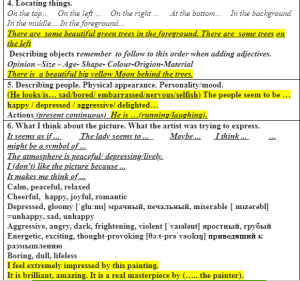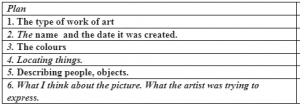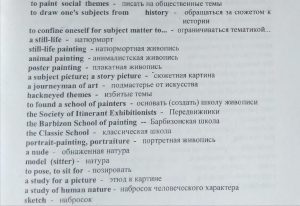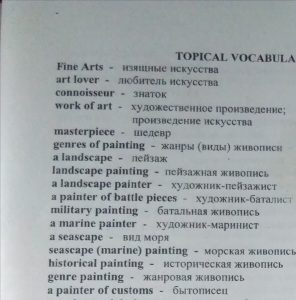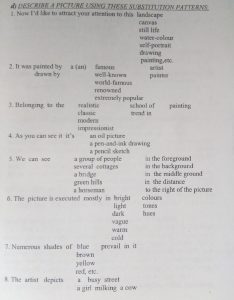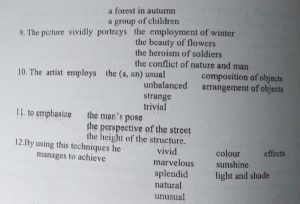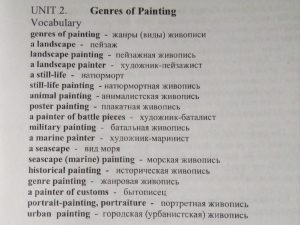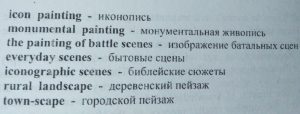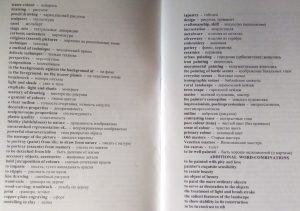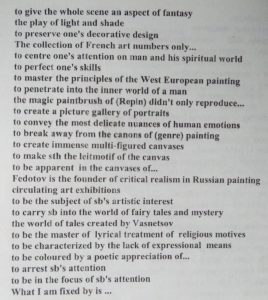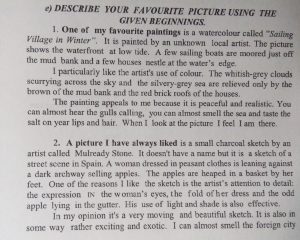Hello,dear students!
In today’s lesson, we are going to learn how to give a great answer to that task. I will explain how to analyse the painting, make notes, pick the right language, and then I will even give you a sample that help you understand the general writing structure of a modal text about a piece of art , use key phrases for describing a painting.
Describe a piece of art that you like. You should say:
– what the piece of art is
– where and when you saw it
– what it looks like or what it show and explain why you like this piece of art.
So what do you have to do?
Well, you need to first think of a piece of art. That could be a painting, a sculpture or an ornament or anything else. Art is a pretty broad term. Now, it is debatable just how wide the definition could be. Some people might say that a movie or a novel or a poem is a work of art. That’s probably true. But the word piece here seems to imply a physical thing, like a painting or a sculpture. Then you have to focus on those ideas.
As for the description of art, it asks:
• When and where did you see this piece of art?
• What does it look like and why do you like it?
Remember also that it just says piece of art. It doesn’t say famous piece of art. This is a small distinction, but it means that maybe your friend made something and you can write about that rather than a famous painting such as the Mona Lisa.
Why is it important to learn how to describe a piece of art?
You might think that describing a painting can be useful only at the museum or in your art class. But we can show you that it is not entirely true. This simple process can bring you more benefits than you can imagine. Here are only a few of them: • Improving your speaking and writing skills. Of course, since we are here to study English, the first benefit is connected to our learning process. When you learn words to describe the painting, you expand your vocabulary, understand how to build sentences, and use them in your speech and writing.
• Learning to understand yourself. Yes, you’ve read it correctly. As we mentioned earlier, one of the best ways to describe art is to start with your feelings. And when you realize what you feel regarding some painting, you will learn how to listen to yourself in other situations.
• Imagination development. You probably remember that in step four of describing a painting, we offered to define a scene using your imagination – guess what is going on, and create your version of events. It will help you develop your fantasy and imagination and become even more creative.
• Increasing knowledge. You already know that to describe a piece of art better, you need to find some information about the artist and the historical background of the painting. It will help you to increase your knowledge of various topics, so you will always be an interesting person to communicate with. Only these four benefits can show you how much profit you have from learning how to describe art. You can use them to discuss paintings, even in your native language. And if you want to master this topic in English, we know precisely how to help you reach this goal.
So, how to describe paintings properly?
Describe your impressions
When discussing a particular painting at the gallery, express your feelings about it. Do you like it or not? Does the picture make you happy or sad? And why does it give you such a mood – because of the colors, composition, or maybe its background history? You can use many adjectives to describe your feeling regarding any piece of art. Here are some of them:
• Positive emotions: inspired, joyful, satisfied, interested, happy, serene, nostalgic, sentimental, excited, impressed, powerful, fascinated, etc.
• Negative emotions: disappointed, sad, moody, gloomy, unsatisfied, scared, nervous, angry, depressing, disgusted, etc. Describe the composition
You can now talk more particularly about the chosen work of art after conveying your feeling from the picture. And the best thing to start describing it is to explain the composition. In layperson’s terms, you need to tell what is depicted on the canvas.
You can use these common expressions and words to describe art composition: in the foreground/background, in the middle, on the right/left side, next to, in front of; asymmetrical, symmetrical, centered; urban landscape, suburban landscape, rural landscape; a historic site, domestic setting, intact nature; horizontal, vertical, circular, triangular.
For example, let’s look at the Mona Lisa (we are confident you’ve seen this one before).
What can you see in this famous painting?
There is a beautiful woman in the foreground. She has long black hair and wears a black dress. In the background is a natural landscape – a river, mountains, and a road. You can be more general when talking about the painting’s composition. Just describe what you can see in the foreground and background, the main shapes of the picture, what is in the center and what is in the distance, etc. The best advice for this step is to tell everything you see, even the smallest details.
Describe the colors
Colors are integral when you need to describe a painting. Of course, we are not telling you to go to the gallery and stand in front of pieces of art saying they are red or yellow. It would be a little bizarre. You can try some other things instead. Here are some adjectives you can use to explain the color palette of the painting: • bright, vibrant, vivid; • hot, cold, warm, cool; • natural, artificial, earthy, rich, intense; • deep, flat, weak, pale, muted; • complementary, quiet, contrasting; • dark, light, monochromatic. Take a look at the painting and try to identify your impression of the colors used. Are they good together? Do they fit the overall idea and composition? Can you identify the primary color palette and what it is? Are there any specific colors you can notice? The more details your eye can catch, the better your description will be. Try to feel the atmosphere the artist created using a specific color and explain it.
Describe the scene
When describing a composition, you explain only the things pictured in the painting. But when discussing the scene, you create your own story based on the painting. Of course, it would be harder to describe the landscape scene because you can only guess the place’s location, city, or country here. But if there are any actions, and you feel a little creative, you can imagine the story behind this picture and add it to your description. Let’s get back to the legendary Mona Lisa. You probably know there are many stories about this masterpiece. So, why don’t we create another one? Take a look at this painting once again, and try to guess a few things. Who do you think this woman is? Maybe she is the wife of the artist. Perhaps she is his mistress. Or possibly, she is just the famous lady of that time, and it’s a custom painting. Where does she live? We know that Da Vinci was born in Italy but spent his last days in France. Hence, maybe it is one of those countries? The number of options is countless. You can choose any picture and make your own vision of it.
Describe the history
Generally, four previous steps would be enough to describe a painting. But if you have a bit more spare time and want to impress whoever you will discuss the art with, you need to do some research. Start with the information about the artist. Find out their date and place of birth, the genres they were working with, and some major events in their life. When you know something about the artist, it will be easier for you to keep the conversation going. Moreover, it will significantly simplify the painting-describing process. After learning some basics about the author, research the information about the painting. Try to learn as much as possible about the events or people pictured on the piece of art. It may be a famous historical event or figure. Maybe, it is the sibling of the artist. The more you find, the better you will understand the painting. Of course, if you’ve decided to do this research, you should skip step four. It won’t be easy to guess and create your versions when you know exactly what the picture is about. But to mention the painting’s history, you need to be sure that you’ve found only relevant information. So pay attention to the smallest details to avoid misunderstandings and confusion.
Conclusion
All in all, discussing a particular piece of art might be more tricky than you thought. But with minimal preparation, you can become a personal guide for your friends on your next visit to the gallery. All you need to do is to remember some basic steps for describing a painting.
1. Find out more about the art and the artist. Scroll through the Internet and visit famous websites like the National Gallery of Art to find information about the chosen painting.
Describe the background history of the author and the painting.
2. Describe your own feelings about the piece of art – what emotions does it evoke?
3. Discuss the composition of the painting – what you can see in the foreground, in the background, etc.
4. The next step is to mention the colors of the painting – what are they?
5. Finally, you can tell the story of the scene. If you’ve done the research mentioned in the first step, you can skip it since you’ve already discussed it. But if you don’t know what is going on, just turn on your imagination and try to guess.
These five steps are the general plan for describing a picture in English.
Typical vocabulary
Genres of painting
Additional word -combinations
Describe your favourite painting using the given beggings

